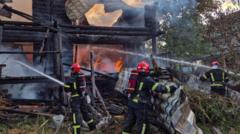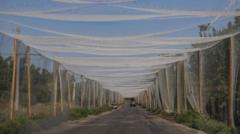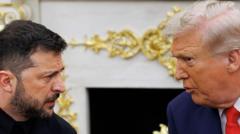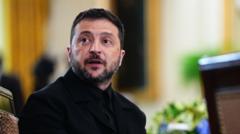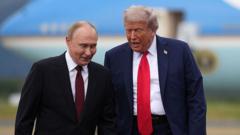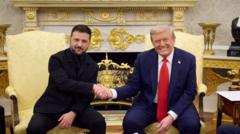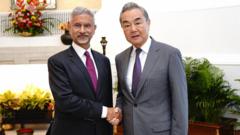In the heart of Ukraine's turmoil, towns like Rodynske reveal the devastating impact of Russian military advancements, particularly their deployment of fibre optic drones that have changed the nature of combat.
The Evolving Battlefield: Ukraine Faces New Drone Threats
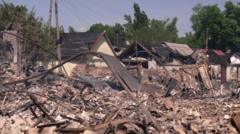
The Evolving Battlefield: Ukraine Faces New Drone Threats
A fresh wave of tactical shifts marks the ongoing war in Ukraine as it grapples with increasingly deadly drone technology.
In the town of Rodynske, a grim aftermath of war hangs in the air as a recent Russian airstrike has left significant destruction. The 250kg glide bomb struck the main administrative building, demolishing three residential blocks and leaving a lingering stench of smoke. Just 15km north of Pokrovsk, a city under intense pressure from Russian forces, Rodynske has become a focal point for aerial assaults as Russia alters its tactics to encircle the city, severing vital supply routes.
Horrifying sounds of artillery fire echo above, signaling the presence of Russian drones, which have swiftly taken on a prominent role in this evolving conflict. As the BBC team reported, their initial visit was interrupted by the drone's ominous whirring, a reminder of the unseen threats lurking nearby. Evidence suggests these drones are launched from newly seized areas, marking a shift in Russia's strategy that emphasizes more sophisticated aerial capabilities.
In Bilytske, a town further from the frontlines, residents recount the horrors of drone attacks. Svitlana, who barely escaped the destruction of her home, describes how their once safe town has become a target. "It's getting worse and worse,” she says, reflecting on the increasing aggression of military operations.
The frontline soldiers echo this sentiment. Members of the 5th Assault Brigade report an alarming increase in Russian assaults, highlighting the combination of rockets, mortars, and drones which are overwhelming their defenses. These new fibre optic drones complicate the battlefield significantly; they utilize a physical connection for control and surveillance, evading traditional electronic warfare defenses that both sides previously implemented.
This tactical shift gives Russia the upper hand in drone warfare, as Ukrainian forces scramble to develop similar technology amid rising concerns for their safety. Soldiers relate stories of spending prolonged periods at the front lines—some up to 120 days—under the constant threat of being spotted and struck by drones.
The psychological toll is immense, as expressed by Maksym, a soldier and father. He reflects on the strain of being separated from his two-year-old son, amidst the chaos of the battlefield. "It's hard, it's really hard. My family really supports me… I do video call him though, so everything is as fine as it could be under the circumstances," he shares, his voice wavering with emotion.
As the war pushes into its fourth summer, Ukraine's fight remains a complex interplay of technology, manpower shortages, and shifting military strategies, each side adapting to the unpredictable nature of modern warfare. The local and global communities continue to watch with bated breath as Ukraine holds fast against the encroaching threat.
Horrifying sounds of artillery fire echo above, signaling the presence of Russian drones, which have swiftly taken on a prominent role in this evolving conflict. As the BBC team reported, their initial visit was interrupted by the drone's ominous whirring, a reminder of the unseen threats lurking nearby. Evidence suggests these drones are launched from newly seized areas, marking a shift in Russia's strategy that emphasizes more sophisticated aerial capabilities.
In Bilytske, a town further from the frontlines, residents recount the horrors of drone attacks. Svitlana, who barely escaped the destruction of her home, describes how their once safe town has become a target. "It's getting worse and worse,” she says, reflecting on the increasing aggression of military operations.
The frontline soldiers echo this sentiment. Members of the 5th Assault Brigade report an alarming increase in Russian assaults, highlighting the combination of rockets, mortars, and drones which are overwhelming their defenses. These new fibre optic drones complicate the battlefield significantly; they utilize a physical connection for control and surveillance, evading traditional electronic warfare defenses that both sides previously implemented.
This tactical shift gives Russia the upper hand in drone warfare, as Ukrainian forces scramble to develop similar technology amid rising concerns for their safety. Soldiers relate stories of spending prolonged periods at the front lines—some up to 120 days—under the constant threat of being spotted and struck by drones.
The psychological toll is immense, as expressed by Maksym, a soldier and father. He reflects on the strain of being separated from his two-year-old son, amidst the chaos of the battlefield. "It's hard, it's really hard. My family really supports me… I do video call him though, so everything is as fine as it could be under the circumstances," he shares, his voice wavering with emotion.
As the war pushes into its fourth summer, Ukraine's fight remains a complex interplay of technology, manpower shortages, and shifting military strategies, each side adapting to the unpredictable nature of modern warfare. The local and global communities continue to watch with bated breath as Ukraine holds fast against the encroaching threat.


